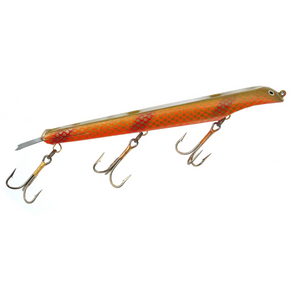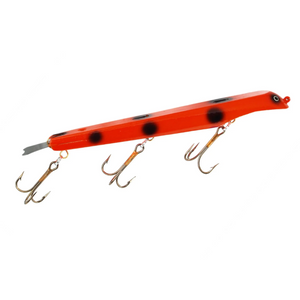Some folks say the musky is a fish of ten thousand casts. But if you’ve ever danced with one, you know its obsession, patience, and grit wrapped into one toothy, unpredictable torpedo.
Canadian musky waters hold some of the biggest and baddest predators on the planet, and 2025 is shaping up to be one of the best years yet to chase them. Whether you're casting double-bladed bucktails from a rocky point in July or trolling giant crankbaits along cabbage edges in October, there’s no shortage of lakes where legends are made.
Keep reading to learn which destinations are heating up this season, smart fishing tips and tactics to try, and the gear you’ll want on your side when you finally connect with a true giant.
The History of Canadian Musky Fishing
There’s something almost mythical about Canadian musky. Old timers will tell stories about 60-inch fish that got away, busted rods, and boats that nearly flipped. Some of them are true. Some are wishful thinking. But they all come from deep respect.
Back in the early 1900s, musky were fished hard. Too hard. Some lakes were nearly wiped clean from overharvest, and the big girls, the 50-inchers and beyond, started disappearing. It wasn’t until catch-and-release became the norm and strict regulations took hold that we saw the species begin to bounce back.
Back then, musky fishing was a game of trial and error. Wooden musky lures, no electronics, braided Dacron line, and stories passed around campfires. Today, we’ve got sonar, GPS mapping, and rods that weigh half what they used to, but the chase? It’s still the same.
Every cast carries a bit of hope, and every follower keeps you hungry. That’s what keeps us coming back for more.
Top Musky Fishing Destinations in Canada
Canada's musky belt stretches from Eastern Ontario into Northwestern Ontario and spills into parts of Quebec and Manitoba. These waters are vast, varied, and home to some of the biggest Canadian musky ever caught.
Lake St. Clair (Ontario)
Often called the musky capital of the world, Lake St. Clair is a trolling paradise. The water is shallow and mostly uniform in depth, so it’s perfect for covering ground. This lake’s musky population is dense, and while it might not produce the longest fish, the action is consistent and hard to beat.
- Hot bait: Jointed crankbaits and trolling bucktails
- Gear pick: The Okuma Cold Water Line Counter Reel is ideal for trolling passes with precision
- Tip: Watch your speed. Some days, 5.5 km/hr works; other times, 8.5 km/h will trigger more hits
Eagle Lake (Northwestern Ontario)
Eagle is big water and big commitment, but the reward? Fish pushing 50 inches or more with regularity. You’ve got every type of structure: reefs, saddles, deep humps, weeds, and current.
This lake sees pressure, but it also produces monsters every year. Work the reefs at sunrise, and don’t ignore midday topwater because those big fish eat when they want to.
- Hot bait: Large rubber baits like Medusas and Pounders
- Gear pick: Daiwa Prorex Musky Rods are lightweight but brutal on follow-through
- Tip: Don’t skimp on your leader. 130-lb fluorocarbon or steel is non-negotiable here
Lake Nipissing (Northeastern Ontario)
Nipissing has become a hotspot for big fish in the last decade, thanks to sound management and angler stewardship. Trolling the outer weed edges in fall is a go-to strategy, but casting deeper breaks near the French River outlet can also pay off big.
- Hot bait: Jerkbaits and big spinnerbaits
- Gear pick: Simms G3 Waders are for when you want to get in tight and cast from shore
- Tip: Focus your efforts around moonrise or moonset windows — the locals swear by it
Ottawa River (Eastern Ontario/Quebec Border)
Huge, powerful, and often under fished, the Ottawa River offers deep holes, timbered banks, and hidden weed beds. From Arnprior to Hawkesbury, musky thrive in this system. Casting structure and trolling the channels both work, depending on the season.
- Hot bait: Bulldawgs and shallow glide baits
- Gear pick: St.Croix Legend Tournament Rod perfectly balances weight and strength
- Tip: Bring backup gear. The Ottawa will test your tackle and your spirit
Lake of the Woods (Ontario/Manitoba Border)
This legendary lake has thousands of islands, endless structure, and musky that’ll haunt your dreams. The number of potential spots can overwhelm newcomers, but focus on cabbage points, current seams, and rocky reefs, especially in the early and late season.
- Hot bait: Topwaters like the Netbait BF Toad and slow-sinking swimbaits
- Gear pick: Huk Rover Jacket in Black because unpredictable weather means layering smart
- Tip: Hire a guide for your first day if it’s your first trip
When to Fish for Musky in 2025
Fishing for Canadian musky involves careful timing. Each season has its own pace, tactics, and character.
Spring (Late June to Early July)
The musky fishing season usually opens in late June in most Ontario zones. The fish are fresh off the spawn, often hanging around shallow bays and weed flats. This is prime time for sight-casting and slow presentations.
- Go-to baits: Suicks, small bucktails, and gliders
- Hot tip: Fish slowly and methodically. Post-spawn muskies can be curious but lazy
- Gear tip: Stay comfortable with Simms wading boots. Your feet will thank you later after being on the water all day.
Summer (July to Early September)
This is your classic peak season. Warm water, active fish, and long daylight hours make for excellent conditions. Focus on weed edges, drop-offs, and the first break into deeper water.
- Go-to baits: Big topwaters, double-blade bucktails, and fast cranks
- Hot tip: Early mornings and late evenings produce your best windows during high heat
Fall (Mid-September to Ice-Up)
Fall is trophy time. Big females start feeding heavily ahead of winter. Fish go deeper, the weeds die off, and trolling big baits becomes the main game.
- Go-to baits: 12-inch crankbaits, rubber baits, and slow-rolled spinnerbaits
- Hot tip: Water temps dropping below 55°F? Time to go big or go home
What Musky Gear to Use and Why It Matters
Musky gear isn’t your average tackle. These fish destroy undersized rods, burn cheap musky reels, and laugh at light lines. Here’s the no-nonsense rundown on what you’ll need.
Rods
You’ll want something in the 8'6" to 9'6" range, rated for heavy lures (2–10 oz). A longer rod gives better casting distance and figure-eight control.
-
Pick: The Daiwa Prorex Stein Musky Rod has a strong backbone and sensitive tips.
Reels
Go with a baitcaster built for power and speed. High gear ratios help burn bucktails, while sturdy internals stand up to abuse.
-
Pick: The Shimano TranX Baitcaster Reel is smooth, salt-tough, and reliable when it counts.
Line and Leaders
Use 80–100 lb braided line for casting and 100–130 lb fluorocarbon or steel leaders. Don’t skip the leader. Muskies will cut braid with a single shake.
Use 80 lb mono when trolling large baits like 12" crankbaits in cold fall water. That bit of give helps prevent pulled hooks when the fish shakes.
-
Bonus Tip: Don’t tempt fate, leaders get nicked, so carry extras.
Musky Lures That Work – Tried and True Picks for 2025
All your lures don’t have to be flashy. Some of the best producers are old standbys with proven track records.
- Chaos Tackle Posseidon 10: A proven best seller for fishing musky. Designed and constructed to the perfect length, weight and balance.
- Musky Innovations Magnum Bull Dawgs: One of the most versatile lures on the market. Especially in the fall when fish are deep and feeding heavily.
- Waterwolf Lures Shadzilla Shallow: A lifelike, shallow-running musky swimbait designed for weed-filled or open waters, offering a strong tail kick and adjustable depth control to trigger strikes from even the most finicky fish.
Why the Figure Eight Matters
Muskies are notorious followers. They’ll shadow a lure all the way in, studying it like a hawk, then turn away at the last second. Say hello to your new hero: the figure eight.
A wide, smooth figure eight keeps that bait moving and gives the fish one last chance to strike. Plenty of muskies are caught within arm’s length of the boat, but only if you’re paying attention.
Every cast should end with a controlled figure eight, especially in clear water. You’d be surprised how many giants finally commit once they see that lure turn the corner. Don’t just reel in and give up, you’ve gotta finish strong.
Landing and Handling Big Fish
Muskies are apex predators, but don’t bounce back easily from bad handling. If you want to catch them tomorrow, take care of them today.
- Use a big rubber net, not nylon
- Keep the fish in the water until you’re ready for a quick photo
- Use long-nose pliers and hook cutters
- Support the fish horizontally and never by the gill plate, jaw, or eyes!
-
Revive it properly before release
It might take 100 or 10,000 casts, but when you finally stick that fish, treat it like gold.
Ready to Chase Giants?
Musky fishing in 2025 is full of opportunity. From exploring big water for the first time to having already logged years of cast counts, there’s always another giant out there waiting to pounce on your line.
Remember the golden rules: respect the water, respect the fish, and don’t let your guard down on the figure-eight.
Shop the Best Musky Fishing Gear at Angling Sports today.








